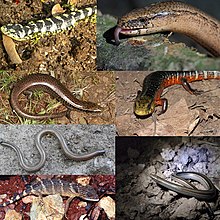Diploglossa
| Diploglossa | |
|---|---|

| |
| Scientific classification | |
| Domain: | Eukaryota |
| Kingdom: | Animalia |
| Phylum: | Chordata |
| Class: | Reptilia |
| Order: | Squamata |
| Infraorder: | Neoanguimorpha |
| Clade: | Diploglossa Cope, 1864 |
| Subclades | |
| |
Diploglossa is a clade of neoanguimorphs represented by the families Xenosauridae, Diploglossidae, Anniellidae and Anguidae, the latter three placed in the superfamily Anguioidea.[1][2][3][4] In the past the Chinese crocodile lizard was classified as a xenosaurid;[5] current molecular work has shown evidence the species related to varanoids in the clade Paleoanguimorpha.[1][2][6]
Below is the phylogeny of the neoanguimorph lineages after Pyron et al. (2013):[2]
| Diploglossa |
| ||||||||||||||||||
References
[edit]- ^ a b Vidal, Nicolas; Hedges, S. Blair (2009). "The molecular evolutionary tree of lizards, snakes, and amphisbaenians". Comptes Rendus Biologies. 332 (2–3): 129–39. doi:10.1016/j.crvi.2008.07.010. PMID 19281946. S2CID 23137302. Archived from the original on 2024-03-09. Retrieved 2023-11-30.
- ^ a b c Pyron; Burbrink; Wiens (2013). "A phylogeny and revised classification of Squamata, including 4161 species of lizards and snakes". BMC Evolutionary Biology. 13: 93. doi:10.1186/1471-2148-13-93. PMC 3682911. PMID 23627680.
- ^ Zheng, Yuchi; Wiens, John J. (2016). "Combining phylogenomic and supermatrix approaches, and a time-calibrated phylogeny for squamate reptiles (lizards and snakes) based on 52 genes and 4162 species". Molecular Phylogenetics and Evolution. 94 (Pt B): 537–547. doi:10.1016/j.ympev.2015.10.009. PMID 26475614.
- ^ Wiens, J. J.; Hutter, C. R.; Mulcahy, D. G.; Noonan, B. P.; Townsend, T. M.; Sites, J. W.; Reeder, T. W. (2012). "Resolving the phylogeny of lizards and snakes (Squamata) with extensive sampling of genes and species". Biology Letters. 8 (6): 1043–6. doi:10.1098/rsbl.2012.0703. PMC 3497141. PMID 22993238.
- ^ Gao, K.; Norell, M. (1998). "Taxonomic revision of Carusia (Reptilia, Squamata) from the late Cretaceous of the Gobi Desert and phylogenetic relationships of anguimorphan lizards". American Museum Novitates (3230): 1–55. hdl:2246/3367.
- ^ Bhullar, B. A. S. (2011). "The power and utility of morphological characters in systematics: a fully resolved phylogeny of Xenosaurus and its fossil relatives (Squamata: Anguimorpha)". Bulletin of the Museum of Comparative Zoology. 160 (3): 65–181. doi:10.3099/0027-4100-160.3.65. S2CID 86328454.
Text is available under the CC BY-SA 4.0 license; additional terms may apply.
Images, videos and audio are available under their respective licenses.
